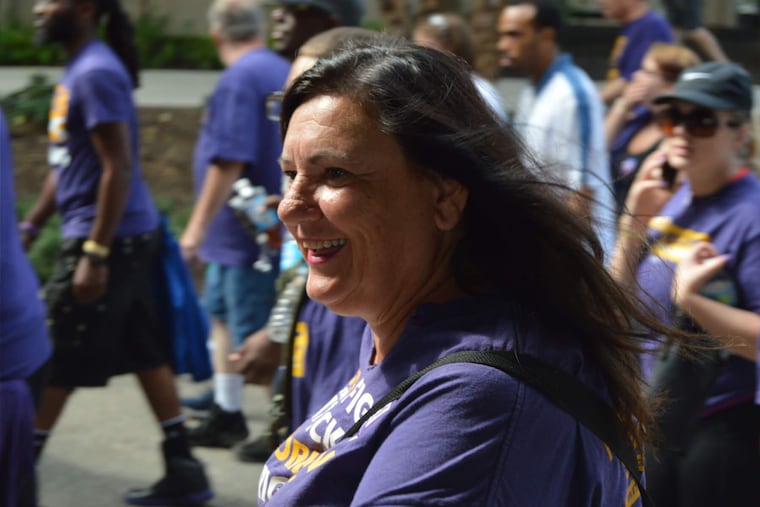Cathy Brady, the force behind the city’s labor monument in Southwest Philly, has died at 62
Brady, a "working class hero," was a towering figure in the Philadelphia labor community.

When Cathy Brady told people about her dream — a monument to the labor movement, right in the working-class neighborhood, her neighborhood, of Southwest Philly — most thought she was crazy.
It was going to be expensive. It was going to take years. And she wanted it where?
"At the beginning, people didn't give her good odds," said Barbara Rahke, executive director of worker safety organization PhilaPOSH, on whose board Ms. Brady served. "But this was Cathy Brady."
The monument to the labor movement was unveiled in 2010, a decade after the project was announced, at Elmwood Park, across from Ms. Brady's house.
It's a legacy she wanted future generations to remember. It's now become her legacy, too.
Ms. Brady, 62, died in her sleep at home Thursday night, Oct. 25, of unknown causes, said her sister, Maria Stearns.
>> READ MORE: From 2000: Park's art will have a blue collar
She was able to make the monument happen by leveraging relationships across the region's labor community. Penny Balkin Bach, executive director of the Association for Public Art, called Ms. Brady a "visionary" who raised $300,000 from union and government sources, half the total amount of the project.
"She begged you, she pressured you, she threatened you," said oil refinery worker Jim Savage with a laugh. After the monument was built, when Savage was president of the refinery workers union, he'd organize a group to go out every spring and clean Elmwood Park.
The monument, a project of the Association for Public Art, is a set of seven bronze tables, meant to look like buttons from a worker's uniform and arranged in a circle, each commemorating an event in the U.S. labor movement, like the formation of the immigrant-led United Farm Workers in 1966. Ms. Brady, her friends said, made sure the monument documented immigrants, women, and people of color in the country's labor history. It's believed to be the first monument in the United States honoring the labor movement, and it's in a neighborhood that was home to thousands of laborers: shipyard workers, electrical workers, steelworkers.
A force in the Philadelphia labor community for more than 40 years, and known as much for her sense of humor as for her passion for uplifting the working class, Ms. Brady, a graduate of West Catholic High School, got her start in the movement as a strike captain during the two-year Eastern Airlines strike that eventually led the company to liquidate in 1991.
She worked first as a cleaner and then a baggage handler, one of the few women working that job at the time.
"All the office work or female-oriented work doesn't pay any money," she told the Daily News during the strike in 1989, when she was a single mother of two. "I need to make at least $10 an hour. If I can't, I'll have to take two jobs."

"She was a union member through and through," said Denis Stephano, former president of the refinery workers union. "She would do anything for you."
After her time at the refinery, she got a job as an organizer with SEIU Healthcare PA, where she spent most of her career. She oversaw a period of enormous growth for the union, successfully organizing thousands of nursing home workers over the last two decades with Wendell Royster, who described himself as her "labor son."
Royster, a formerly incarcerated nursing home worker who climbed the ranks to become the first black vice president at SEIU Healthcare PA, said it was Ms. Brady's mentoring that took him from "handcuffs to cufflinks." It was Ms. Brady who threw his name into the ring to become vice president.
She took a job as a federal mediator two years ago to spend more time with her family, said Kathy Black, treasurer of the Philadelphia chapter, Coalition of Labor Union Women (CLUW), though it pained her to step away from progressive political causes, as the job required her to be neutral.
Ms. Brady, her sister said, was devoted to her family and often took her sisters and nieces to marches and canvassing outings.
"We all had to walk the picket line with her at some point," Stearns said.
In 2017, Philly CLUW, on whose board she served for years, named her Union Woman of the Year.
"She was a working-class hero," said Matt Yarnell, president of SEIU Healthcare PA.
She is survived by her mother, Lucy; daughter, Machele; son, Tom; two grandchildren, seven siblings, and 26 nieces and nephews.
A viewing will be from 6 to 9 p.m. Thursday, Nov. 1, at White Luttrell Funeral Home, 311 N. Swarthmore Ave., Ridley Park. There will also be a viewing from 9:30 to 10:30 a.m. Friday, Nov. 2, followed by a Funeral Mass, at Divine Mercy Church, 6667 Chester Ave.
Donations may be made to Philly CLUW, 22 S. 22nd St., Second Floor, Philadelphia, Pa. 19103, or the Pennsylvania Horticultural Society at https://phsonline.org/donate. Also, donations for a memorial being organized by SEIU Healthcare PA can be made to www.gofundme.com/in-memory-of-cathy-brady.